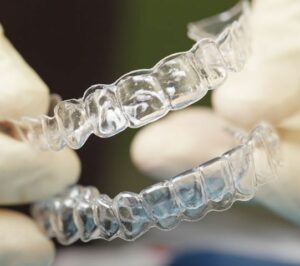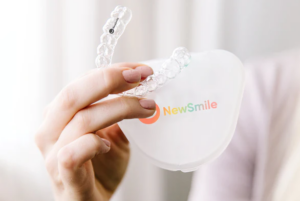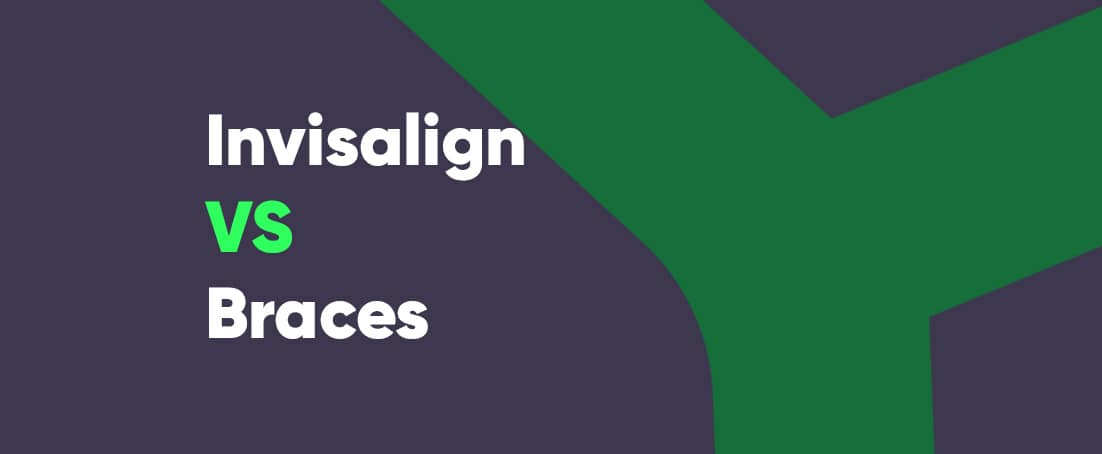In the ever-evolving world of orthodontics, the debate between braces and Invisalign as effective treatment approaches continues in 2024. Several scientific studies, including this comparative evaluation, have shed light on the differences between braces and Invisalign aligners, comparing across parameters such as aesthetics, effectiveness, and cost. These expert insights and user reviews help us make an informed choice.
This blog reveals the winner (based on rigorous research, not just hype)! Let’s delve into the latest findings to determine which among Invisalign and braces reign supreme in 2024.
Table of Contents:
Effectiveness and Treatment Duration
For those looking for worthwhile options for teeth straightening without braces, comparing the effectiveness of Invisalign and braces is helpful. Invisalign clear aligners emerge as a preferred option in dentistry for mild to moderate dental issues, offering discreet treatment.
Moreover, Invisalign may have a quicker treatment time. The average Invisalign treatment duration is 12 to 18 months, potentially shorter than braces, which typically range from 12 to 36 months. Read our comprehensive analysis of “Are aligners better than braces?”
A comparative study reveals that Invisalign is good at moving teeth in small steps and can take less time for treatment. Braces, on the other hand, braces are better at making sure your teeth fit together properly and stay in place after treatment. However, Invisalign clear aligners may not be suitable for severe dental issues, such as severely crooked teeth and severe overbites, where braces are deemed more effective.
Expert Opinion and Research
Beyond aesthetics and comfort, Invisalign’s effectiveness is backed by scientific research and expert opinions. In a study comparing conventional fixed appliances and Invisalign aligners, the Invisalign group experienced a 67% reduction in total treatment time. This highlights that Invisalign® will be faster than braces in many cases, achieving desired results effectively.
Dr. Jonathan Bennett, a renowned orthodontist, states, “Invisalign technology allows for precise tooth movement, often achieving similar results to traditional braces in mild to moderate cases.” He emphasizes the benefits of predictable treatment plans and improved patient compliance due to the removable nature of aligners.
Another study published in the Turkish Journal of Orthodontics concludes that clear aligners are an aesthetic and comfortable choice instead of regular braces. People using clear aligners find it easier to keep their gums healthy, and they get fewer white spots on their teeth during treatment.
Remember, consulting an orthodontist remains crucial for an individualized assessment and treatment plan. However, the growing body of research and expert endorsements paint a positive picture of Invisalign’s effectiveness as a viable orthodontic option.
Invisalign Alternatives

- Made from BPA free transparent material
- Optimal comfort and discretion, improving treatment experience
- Much less treatment time than braces
- Remote monitoring and support through My Byte app

- More affordable than braces and other clear aligner brands
- Removable, easing oral hygiene
- Personalized treatment plans

- FDA approved design
- Accepts FSA, HSA
- Candid App allows remote monitoring
Clear aligners are a discreet and comfortable alternative to traditional braces, offering a path to a confident smile without the hassle. It is clear that Invisalign has numerous advantages over braces. But Invisalign alternatives can present several other added avantages, including cost effectiveness and convenience.
Our top recommendation is Byte, which offers risk-free trial and a refundable Byte impression kit. Their smooth, comfortable aligners prioritize gentle tooth movement. Byte stands out with its innovative HyperByte technology, utilizing vibrations to ensure proper aligner fit. Their flexible payment plans and impressive results in as little as 3 months make Byte a compelling choice.
AlignerCo is another good option, focusing on affordability and speed. Multiple payment plans cater to various budgets, and include a free whitening kit for an extra smile boost. The mail-in impression kit and online treatment plan empower you to straighten your smile entirely from the comfort of your home, eliminating the need for frequent in-person appointments.
Another worthy option is Candid, which caters to a wider range of misalignments, tackling both mild and severe cases. Their network of over 300 dental providers across the US ensures remote monitoring and expert support throughout your treatment. The cost of Candid teeth aligners falls slightly below Invisalign, making it a budget-conscious option.
Consulting a dentist or orthodontist is crucial before choosing any aligner treatment. They can assess your individual needs and recommend the best option for your unique smile journey.
Comparison Table (Braces vs. Invisalign)
| Aligners (Invisalign) | Braces | |||
| Pros | Cons | Pros | Cons | |
| Aesthetics and Comfort |
|
|
|
|
| Maintenance & Oral Hygiene |
|
|
|
|
| Dietary Considerations |
|
|
|
|
Aesthetics and Comfort
Unlike traditional braces, Invisalign utilizes clear, custom-made plastic trays that fit snugly over your teeth, gently straightening them while remaining almost unnoticeable to others. Invisalign® is often preferred because it’s practically invisible. It blends seamlessly with your natural teeth, which means no bulky brackets or wires of orthodontic implants to detract from your appearance.
While traditional braces often come with discomfort due to metal brackets rubbing against your cheeks and gums, Invisalign offers a gentle alternative. The smooth plastic aligners from Invisalign minimize irritation and the risk of mouth sores, ensuring a more comfortable orthodontic treatment journey. Plus, the removable nature of Invisalign allows you to take them out for eating, brushing, and flossing, providing greater freedom and convenience.
Embracing Invisalign doesn’t mean compromising on comfort. Wondering how to comfortably fit the aligners? Consult your dentist or orthodontist for personalized guidance. They can answer your questions and ensure a smooth, confident smile transformation with Invisalign.
Invisalign vs Braces Winner
While both Invisalign clear aligners and braces are effective orthodontic treatment options, when it comes to aesthetics and comfort, Invisalign reigns supreme. Its virtually invisible clear aligners ensure you smile with confidence, unlike the noticeable metal brackets and wires of braces. Plus, the smooth plastic minimizes irritation and mouth sores compared to potential discomfort from braces.
Maintenance and Oral Hygiene
Maintaining a clean smile is crucial for successful orthodontic treatment, but the ease of hygiene varies significantly between Invisalign aligners and traditional braces.
The biggest perk with Invisalign treatment is that you can take your aligners out for brushing and flossing, allowing easier access to all tooth surfaces. This translates to better plaque removal, potentially minimizing the risk of cavities and gum disease. A study even found that Invisalign patients experienced better periodontal health during treatment compared to those with traditional braces.
You should follow our aligners cleaning guide for proper care. It typically involves using lukewarm water, a soft-bristled toothbrush, and specific aligner cleaning solutions to keep them fresh and bacteria-free.
As opposed to Invisalign, traditional braces require extra effort for cleaning. Brackets or wires create nooks and crannies where food particles get trapped, demanding meticulous cleaning with interdental brushes, floss threaders, and special techniques. Difficulty cleaning can lead to plaque buildup, increasing the risk of dental cavities and gingivitis.
Invisalign vs Braces Winner
When it comes to keeping your smile sparkling clean during treatment, Invisalign shines brighter than braces. Its removable aligners allow effortless brushing and flossing, potentially lowering plaque, cavity and gum disease risks. For an easier, healthier treatment journey where maintenance is a breeze, choose Invisalign clear aligners.
Dietary Considerations
While both Invisalign and braces straighten your smile, their impact on dietary freedom differs significantly. Removable aligners by Invisalign let you savor any food or drink, from sticky candies to crunchy popcorn. Simply take them out, enjoy, and clean them thoroughly and wear them back. With Invisalign, you can Indulge freely and maintain good oral hygiene by brushing and flossing after.
With traditional braces treatment, mindful munching is required, and your orthodontist will suggest what to avoid. Certain foods such as sticky candies, nuts, and hard pretzels can damage brackets and wires, requiring repairs and delaying progress. Cleaning teeth with traditional braces after every snack can be cumbersome, making unplanned treats less convenient.
Invisalign vs Braces Winner
In comparison to braces, Invisalign wins the diet flexibility battle. The ability to remove the Invisalign aligners offers greater freedom and spontaneity without compromising your orthodontic treatment.
Invisalign vs Braces Cost Comparison
When considering orthodontic treatment, both Invisalign aligners cost and braces cost factor heavily into the decision. While Invisalign treatment typically range from $2,800 to $9,000, treatment with braces can cost anywhere from $4,000 to $10,000. Invisalign treatment is often a little more expensive than braces, but Invisalign cost includes impression kits, custom aligners, and supplementary tools. On the other hand, braces might require additional charges for fine tuning the fit, replacements, and retainers.
Braces are more likely to be partially covered by certain insurance plans, but Invisalign aligners too get covered by some plans now. You can also use your HSA or FSA to pay for the Invisalign treatment. Additionally, Invisalign’s shorter treatment duration (averaging 12-18 months compared to 18-36 months duration for braces) translates to potential long-term savings on fewer appointments and overall treatment time.
Final Words: Braces or Invisalign?
In the debate between braces or Invisalign aligners, consider Invisalign’s intangible benefits in comparison to braces. Increased comfort, aesthetic discretion, and dietary freedom can boost self-confidence, potentially making the initial investment more valuable over time.
Your orthodontist will assess the complexity of your case and determine if going for traditional braces is better for you. If you are the right candidate for clear aligners, the orthodontist will guide you in detail about Invisalign.
Ultimately, choose between Invisalign vs braces based on your individual preferences and needs. Make an informed decision that aligns with your lifestyle and goals for a smile that not only looks great but also feels great.

